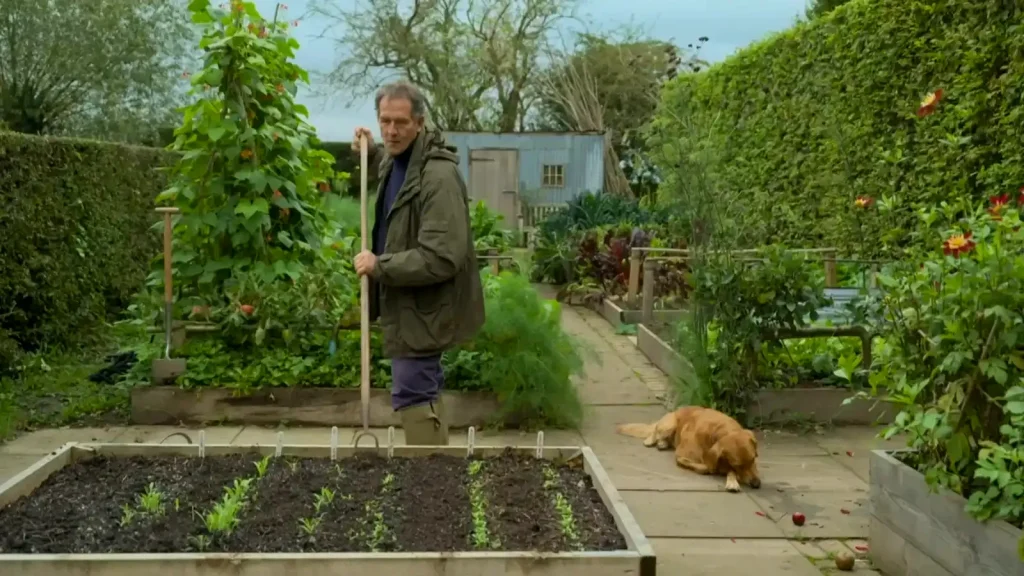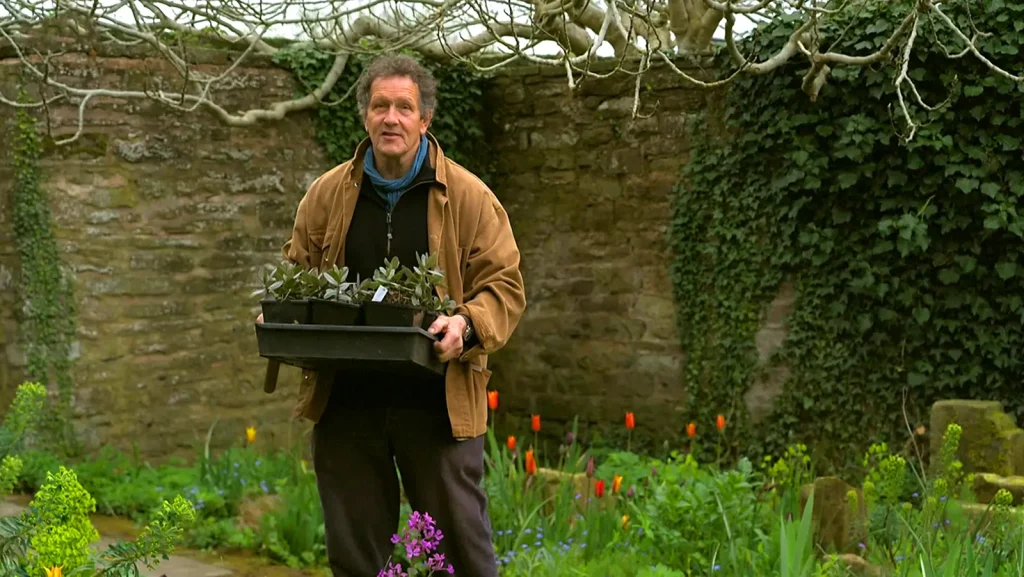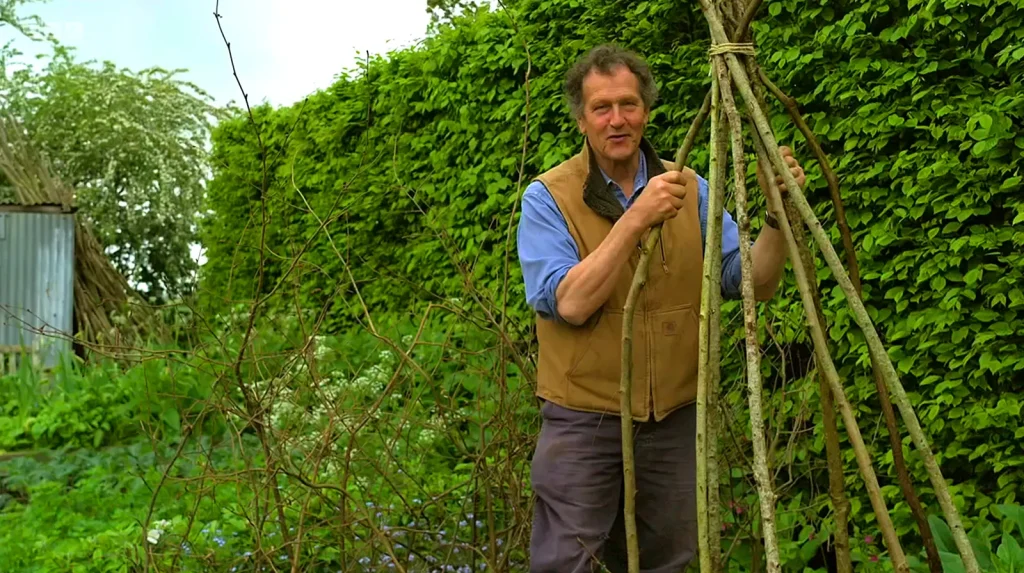Autumn has arrived, and that means it’s apple harvest time on Gardeners World 2024 Episode 29. Monty Don kicks things off by making the most of this season’s bounty, gathering windfall apples from his orchard. There’s nothing quite like juicing those fallen treasures – a fresh, homemade apple juice is a taste of the orchard in every sip, as close to autumn as you can get in a glass.
It’s a simple pleasure, but one that speaks of the heart of gardening: taking what nature provides and turning it into something nurturing and delicious. The crisp air, the golden leaves underfoot, and the scent of apples – it all combines to create an experience that’s almost magical. But that’s just the beginning of the season’s wonders in Monty’s garden.
In the beloved Cottage Garden, Monty adds a new shrub, a carefully selected addition that promises to bring beauty and structure to the flower beds. He knows that every plant plays a role, and this new shrub will be both a visual delight and a contributor to the ecosystem. As Monty digs the hole and settles the plant into its new home, there’s a sense of quiet fulfillment – the knowledge that he is creating something that will continue to grow and flourish for years to come.
This season, he also turns his attention to indoor cheer, potting up amaryllis bulbs so they’ll bloom in time for Christmas. Amaryllis – with their bold, trumpet-shaped flowers – are like nature’s holiday ornaments, ready to brighten those winter days when color feels scarce. The anticipation of seeing those vibrant blooms open during the cold months is a reminder that even in the darkest times, beauty can be cultivated.
Monty isn’t just about the here and now – he’s also laying foundations for future growth. His spring cabbage, now being tucked into the soil, will be among the first fresh greens to grace next year’s kitchen. There’s something incredibly satisfying about that promise of growth, the knowledge that today’s work in the garden is tomorrow’s feast. Gardening is, at its core, an act of hope. It’s about investing in the future, believing that the seeds we sow today will bear fruit – or in this case, leafy greens – when we need them most.
Meanwhile, Monty digs into an unsung hero of gardening: leafmould. This autumnal treasure, formed from decomposing leaves, is a resource that money simply can’t buy. Rich, dark, and full of nutrients, it’s like a gardener’s secret weapon, enhancing soil and adding the whisper of the woodland to beds and borders. Leafmould is a testament to nature’s ability to recycle and rejuvenate – turning what might seem like waste into something life-giving.
Elsewhere on this week’s episode, Joe Swift steps out to visit the garden of Chelsea award-winning designer Tom Hoblyn. There, Joe gets hands-on with a lesson in bud grafting. The technique, used to combine the best qualities of different plants, feels a little like matchmaking for the plant world – pairing strengths and creating something even more extraordinary.
Bud grafting is a reminder of the art and science behind gardening – it’s not just about planting seeds and hoping for the best; it’s about understanding the intricate details of how plants grow and how we can guide them to be their very best. It’s always a joy to learn from seasoned gardeners like Tom, whose creations are built on both creativity and horticultural know-how. Tom’s garden is a reflection of his expertise, each plant chosen with care, each combination designed to create harmony and beauty.
Sue Kent invites us into her own garden for a reflective moment. She’s taking stock, looking back over the highs and lows of the year. It’s a relatable and heartfelt scene – every gardener knows the triumphs and trials of nurturing a plot. Some things thrive beyond expectation, while others may falter despite our best efforts.
Gardening teaches us humility; we can do everything right, and still, nature will have the final say. Sue’s reflections remind us that gardening is not just about plants but also about patience, resilience, and the joy that comes from the journey. It’s about learning to accept the losses, celebrate the victories, and keep moving forward. The garden is a mirror of life – unpredictable, sometimes challenging, but ultimately rewarding. Sue’s honesty about her experiences is both comforting and inspiring, encouraging all of us to keep our hands in the soil, no matter the setbacks.
The episode also takes us down to Devon, where a gardener has created a space brimming with color that fully embraces its scenic setting. It’s a place where nature and nurture have blended seamlessly, where the garden doesn’t just sit within its environment – it sings along with it. Flowers bloom in hues that echo the landscape, making the garden feel like an extension of the natural beauty around it. For anyone needing inspiration for making the most of their surroundings, this garden offers plenty of ideas.
Gardeners World 2024 Episode 29
The gardener has managed to capture the essence of Devon’s rolling hills and vibrant countryside, creating a sanctuary that feels both cultivated and wild. It’s a reminder that the best gardens are those that respect and enhance their surroundings, that work with nature rather than against it. Walking through this garden is like stepping into a living painting, each flower and leaf contributing to the overall masterpiece.
No episode of Gardeners’ World would be complete without a little love for houseplants, and this week’s guest is writer and houseplant expert Jane Perrone. Jane brings her wealth of knowledge to bear, sharing tips on some of the best houseplants to grow, from hardy, happy houseplants that bring life to any space to those that require just a touch of extra care. Houseplants are more than just decorations – they are living beings that add warmth and vitality to our homes. Jane’s passion for these leafy companions is evident as she discusses their needs and quirks.
Whether you’re a long-time indoor gardener or someone who’s just brought home their first leafy friend, Jane’s advice is sure to inspire. There’s something special about the bond we form with our houseplants – they’re companions that grow alongside us, adding vibrancy and a sense of wellbeing to our homes. A well-chosen houseplant can transform a room, turning it from a simple space into a thriving, green oasis.
From Monty’s apple harvest and spring cabbages to Sue’s reflections and Jane’s houseplant wisdom, Gardeners’ World 2024, Episode 29, is a celebration of the garden’s changing seasons. It’s a reminder that gardening is about both the everyday tasks and the dreams we plant for the future. Each episode invites us into the rhythm of the natural world – a rhythm that promises renewal, growth, and beauty in all its forms. The garden is a place where time moves differently, where the small acts of today become the wonders of tomorrow. It’s a space where we can find peace, purpose, and a connection to something greater than ourselves.
So whether you’re juicing apples, potting up amaryllis, or thinking ahead to next spring’s cabbages, there’s always something to do, something to enjoy, and something to look forward to in the garden. And as Monty and his fellow gardeners share their wisdom, they remind us that gardening is about more than just plants. It’s about connecting – with nature, with each other, and with something deep within ourselves. Gardening is a journey, one that teaches us to appreciate the present, plan for the future, and find joy in every step along the way. It’s a celebration of life, in all its forms, and an invitation to grow alongside the world around us.
Conclusion Gardeners World 2024 Episode 29
As we close this episode of Gardeners’ World 2024, it’s clear that the garden is more than just a place for plants. It’s a living, breathing tapestry woven with the seasons, each thread representing growth, beauty, and resilience. Monty Don’s apple harvest is a reminder of the simple joys we can find in nature – a moment to gather what has fallen and transform it into something nourishing. Like the apples, we too gather what life gives us, finding sustenance in the smallest pleasures.
The addition of a new shrub to Monty’s Cottage Garden speaks to the gardener’s eternal hope – planting for tomorrow, believing in the promise of future blooms. Each time we place a seed or shrub into the ground, we’re laying down roots not just for our gardens but for our souls. The anticipation of spring cabbages or the vivid burst of amaryllis at Christmas offers a comforting certainty: no matter the season, the garden will give back what we’ve nurtured.
Sue Kent’s reflections on the highs and lows of the year mirror the unpredictability of life itself. Gardening, like life, is full of surprises. Some plans flourish, while others fade despite our best efforts. But in both gardening and life, there’s always hope. Every setback becomes a lesson, every success a moment to celebrate. The garden, in its quiet way, teaches us patience, perseverance, and the joy of the journey.
As we step back, the gardens in Devon and the wisdom of houseplant expert Jane Perrone remind us that our connection to nature extends beyond the outdoors. Whether in a sprawling landscape or the small corner of a home, we find peace, beauty, and companionship in the plants we nurture.
Ultimately, gardening is a reflection of life’s rhythm – an ongoing cycle of growth, change, and renewal. It teaches us to look ahead, to dream of what could be, while appreciating the simple, grounding moments of today. As we carry these lessons forward, we are reminded that in the garden, and in life, there is always something new to discover, something to cherish, and something to hope for.
FAQ Gardeners World 2024 Episode 29
Q: What is the most effective method for harvesting apples in autumn?
A: The most effective way to harvest apples in autumn is to pick them when they easily detach from the tree. Gently twist the apple, and if it comes off without resistance, it is ready for harvest. Gather windfall apples promptly for fresh use or juicing, as they can spoil quickly if left on the ground.
Q: How can I use leafmould in my garden effectively?
A: Leafmould is an excellent resource for improving your garden. It serves as a soil conditioner that enhances soil structure, retains moisture, and boosts nutrient levels. Additionally, leafmould is ideal for mulching beds and borders, as it helps regulate soil temperature and encourages healthy root development.
Q: Why is Monty Don potting amaryllis bulbs for Christmas?
A: Monty is potting amaryllis bulbs now to ensure they bloom by Christmas. These vibrant flowers add a festive and natural touch to the winter season, providing bright colors when outdoor gardens are largely dormant. The blooms can transform indoor spaces and bring much-needed cheer during the cold months.
Q: What is bud grafting, and what are its advantages?
A: Bud grafting is a horticultural technique used to combine desirable traits of different plants. It involves joining a bud from one plant to the rootstock of another. This method is advantageous because it allows gardeners to create plants that are stronger, healthier, and possess the most favorable characteristics of both parent plants, much like a botanical form of matchmaking.
Q: How can I prepare my garden for next spring?
A: Preparing your garden for spring involves taking proactive steps now. Plant cold-hardy vegetables like spring cabbages, apply leafmould as mulch to protect soil, and clear out old annuals to make room for new growth. Proper planning and maintenance during the autumn months will ensure a thriving, productive garden as the weather warms.
Q: What are the benefits of cultivating houseplants?
A: Houseplants offer numerous benefits to your indoor environment. They help purify the air by absorbing toxins and releasing oxygen, enhance the visual appeal of your living spaces, and contribute to a sense of calm. Caring for houseplants can also have therapeutic effects, providing a rewarding, stress-relieving activity that connects you with nature.
Q: How should I make use of windfall apples?
A: Windfall apples are ideal for making apple juice or preserves. Although they often fall when slightly overripe or bruised, their flavor remains excellent. It is best to use them promptly to avoid spoilage and to create tasty seasonal treats like fresh cider, applesauce, or apple jam.
Q: How do gardens foster a connection with nature?
A: Gardens serve as a place where human care and natural processes intersect. Working in a garden allows us to engage directly with the soil, grow food, and observe the changing seasons. Gardening encourages mindfulness, grounding us in the natural rhythms of life, and providing a tranquil escape from the demands of modern life.
Q: How can I effectively add a new shrub to my garden?
A: To effectively add a new shrub to your garden, select a suitable location with adequate sunlight. Dig a hole twice the width of the root ball, and plant the shrub at the same depth as it was in its container. Backfill the hole with soil, water thoroughly to eliminate air pockets, and apply mulch around the base to help retain moisture and prevent weeds.
Q: Why is gardening often described as a journey?
A: Gardening is described as a journey because it evolves continuously over time. Each season presents new challenges and rewards, from the initial planting of seeds to the final harvest. Gardening is not only about cultivating plants but also about fostering patience, optimism, and a deep connection to the natural cycles of growth and renewal. It requires dedication and an ongoing commitment to nurturing life, making it a process of continual learning and personal growth.




